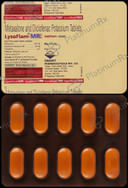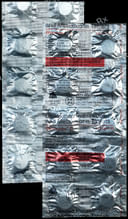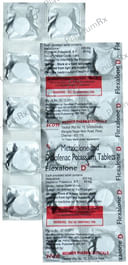Diclofenac + Metaxalone
Uses
Diclofenac and Metaxalone Uses Diclofenac and Metaxalone are used to relieve pain caused by muscle spasms.
How it Works
How Diclofenac + Metaxalone works: Diclofenac is a non-steroidal anti-inflammatory drug (NSAID) that blocks the release of certain chemical messengers responsible for pain and inflammation, including redness and swelling. Metaxalone is a muscle relaxant that acts on the centers in the brain and spinal cord to alleviate muscle stiffness and spasms. It helps relieve pain and improves muscle movement.
Side Effects
Common side effects of Diclofenac and Metaxalone include nausea, vomiting, stomach pain or epigastric pain, heartburn, diarrhea, sleepiness, and loss of appetite.
Expert Advice
- Diclofenac + Metaxalone helps relieve pain and muscle spasms that may occur due to strains, sprains, and muscle injuries.
- It is typically used in conjunction with rest and physical therapy.
- It may cause dizziness; therefore, do not drive or engage in activities requiring concentration until you understand how it affects you.
- Avoid consuming alcohol while taking Diclofenac + Metaxalone, as it may lead to excessive drowsiness.
Other Combinations
Diclofenac diethylamine + Linseed Oil + Methyl Salicylate + Menthol
Diclofenac diethylamine + Methyl Salicylate + Oleum Lini + Menthol
Dextropropoxyphene + Diclofenac + Paracetamol (Acetaminophen)
Chlormezanone + Diclofenac + Paracetamol (Acetaminophen)
Capsaicin + Diclofenac + Menthol + Methyl Salicylate
Diclofenac + Dicyclomine
Diclofenac + Famotidine
Diclofenac + Fenpiverinium + Pitofenone
Diclofenac + Linseed Oil + Menthol + Methyl Salicylate
Diclofenac + Magnesium Trisilicate + Paracetamol (Acetaminophen)
Diclofenac + Menthol + Methyl Salicylate
Diclofenac + Methocarbamol
Diclofenac + Paracetamol (Acetaminophen)
Diclofenac + Serratiopeptidase
Diclofenac + Thiocolchicoside
Diclofenac + Tramadol
Diclofenac diethylamine
Chlorpheniramine Maleate + Diclofenac + Magnesium Trisilicate + Paracetamol (Acetaminophen)
Chlorpheniramine Maleate + Diclofenac + Paracetamol (Acetaminophen)
Camphor + Capsaicin + Diclofenac + Menthol + Mephenesin
Camphor + Diclofenac + Menthol + Methyl Salicylate + Thiocolchicoside
Absolute Alcohol + Diclofenac + Menthol + Methyl Salicylate
Chlorzoxazone + Diclofenac + Dicyclomine
Chlorzoxazone + Diclofenac + Magnesium Trisilicate + Paracetamol (Acetaminophen)
Chlorzoxazone + Diclofenac + Paracetamol (Acetaminophen)
Chlorzoxazone + Diclofenac + Tramadol
Capsaicin + Diclofenac + Linseed Oil + Menthol + Methyl Salicylate
Capsaicin + Diclofenac + Menthol + Methyl Salicylate + Pregabalin
Bromelain + Diclofenac + Papain + Rutoside + Trypsin Chymotrypsin
Bromelain + Diclofenac + Rutoside + Trypsin Chymotrypsin
Benzyl Alcohol + Diclofenac + Fenpiverinium + Pitofenone
Benzyl Alcohol + Diclofenac + Lidocaine (Lignocaine) + Linseed Oil + Menthol + Methyl Salicylate + Tramadol
Benzyl Alcoholv/v + Diclofenac + Thiocolchicoside
Cyclobenzaprine + Diclofenac + Linseed Oil + Menthol + Methyl Salicylate
Diclofenac + Dicyclomine + Paracetamol (Acetaminophen)
Diclofenac + Doxycycline + Serratiopeptidase
Diclofenac + Drotaverine
Diclofenac + Eperisone
Diclofenac + Famotidine + Paracetamol (Acetaminophen)
Diclofenac + Famotidine + Serratiopeptidase
Diclofenac + Gabapentin + Methyl Salicylate
Diclofenac + Heparin
Diclofenac + Lidocaine (Lignocaine) + Linseed Oil + Menthol + Mephenesin + Methyl Salicylate
Diclofenac + Linseed Oil + Menthol + Methyl Salicylate + Thiocolchicoside
Diclofenac + Linseed Oil + Menthol + Methyl Salicylate + Tramadol
Diclofenac + Menthol + Mephenesin + Methyl Salicylate + Turpentine Oil
Diclofenac + Methocarbamol + Paracetamol (Acetaminophen)
Diclofenac + Methyl Salicylate + Menthol + Oleum Lini
Diclofenac + Misoprostol
Diclofenac + Nimesulide
Diclofenac + Omeprazole
Diclofenac + Pantoprazole
Diclofenac + Paracetamol (Acetaminophen) + Serratiopeptidase
Diclofenac + Paracetamol (Acetaminophen) + Thiocolchicoside
Diclofenac + Paracetamol (Acetaminophen) + Tizanidine
Diclofenac + Paracetamol (Acetaminophen) + Tramadol
Diclofenac + Paracetamol (Acetaminophen) + Trypsin Chymotrypsin
Diclofenac + Rabeprazole
Diclofenac + Serratiopeptidase + Tizanidine
Diclofenac + Tizanidine
Diclofenac + Tolperisone
Diclofenac + Tranexamic Acid
Diclofenac + Trypsin Chymotrypsin
Alcohol + Diclofenac + Methyl Salicylate
Related Medications
Diclofenac 50mg + Metaxalone 400mg

₹180

₹119.5
MRP ₹202.5
Diclofenac 50mg + Metaxalone 400mg

₹145

₹119.5
MRP ₹202.5
Diclofenac 50mg + Metaxalone 400mg

₹200

₹119.5
MRP ₹202.5
Diclofenac 50mg + Metaxalone 400mg

₹136

₹119.5
MRP ₹202.5
Diclofenac 50mg + Metaxalone 400mg

₹95

₹119.5
MRP ₹202.5
Diclofenac 50mg + Metaxalone 400mg

₹135

₹119.5
MRP ₹202.5
Diclofenac 50mg + Metaxalone 400mg

₹119.5
MRP ₹202.5
Diclofenac 50mg + Metaxalone 400mg

₹188.5

₹119.5
MRP ₹202.5
Diclofenac 50mg + Metaxalone 400mg

₹135

₹119.5
MRP ₹202.5
Diclofenac 50mg + Metaxalone 400mg

₹721

₹119.5
MRP ₹202.5
Diclofenac 50mg + Metaxalone 400mg

₹140

₹119.5
MRP ₹202.5
Diclofenac 50mg + Metaxalone 400mg

₹149

₹119.5
MRP ₹202.5
Diclofenac 50mg + Metaxalone 400mg

₹135

₹119.5
MRP ₹202.5
Diclofenac 50mg + Metaxalone 400mg

₹137

₹119.5
MRP ₹202.5
Diclofenac 50mg + Metaxalone 400mg

₹115

₹119.5
MRP ₹202.5
Diclofenac 50mg + Metaxalone 400mg

₹95.8

₹119.5
MRP ₹202.5
Diclofenac 50mg + Metaxalone 400mg

₹139

₹119.5
MRP ₹202.5
Diclofenac 50mg + Metaxalone 400mg

₹209

₹119.5
MRP ₹202.5
Diclofenac 50mg + Metaxalone 400mg

₹91

₹119.5
MRP ₹202.5
Diclofenac 50mg + Metaxalone 400mg

₹66

₹119.5
MRP ₹202.5
Diclofenac 50mg + Metaxalone 400mg

₹150

₹119.5
MRP ₹202.5
Diclofenac 50mg + Metaxalone 400mg

₹145

₹119.5
MRP ₹202.5
Diclofenac 50mg + Metaxalone 400mg

₹285

₹119.5
MRP ₹202.5
Diclofenac 50mg + Metaxalone 400mg

₹160

₹119.5
MRP ₹202.5
Diclofenac 50mg + Metaxalone 400mg

₹184.3

₹119.5
MRP ₹202.5